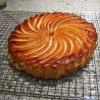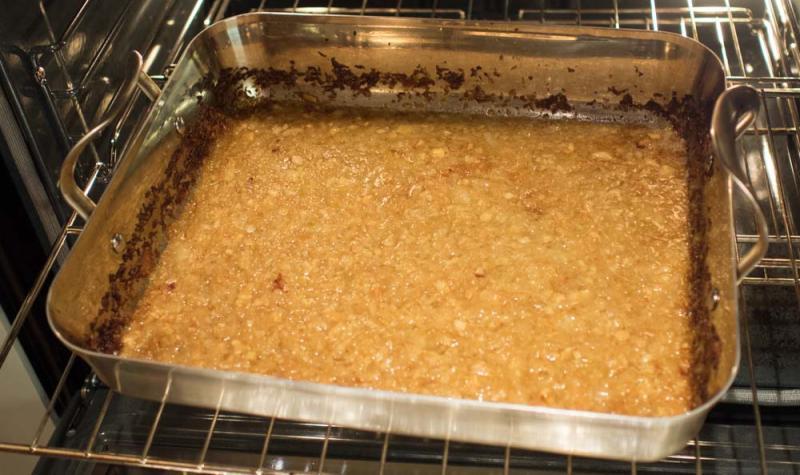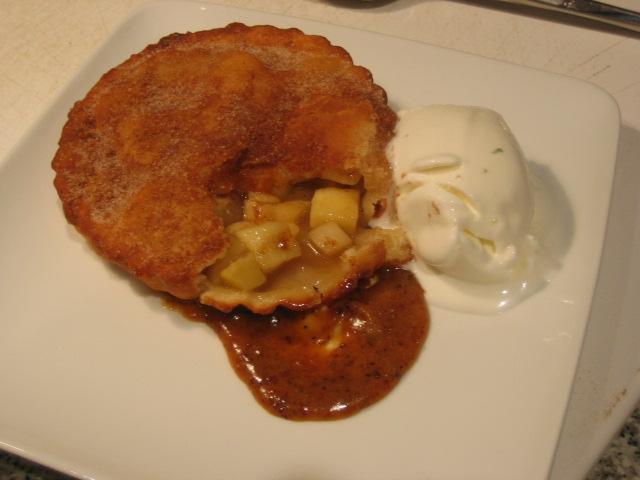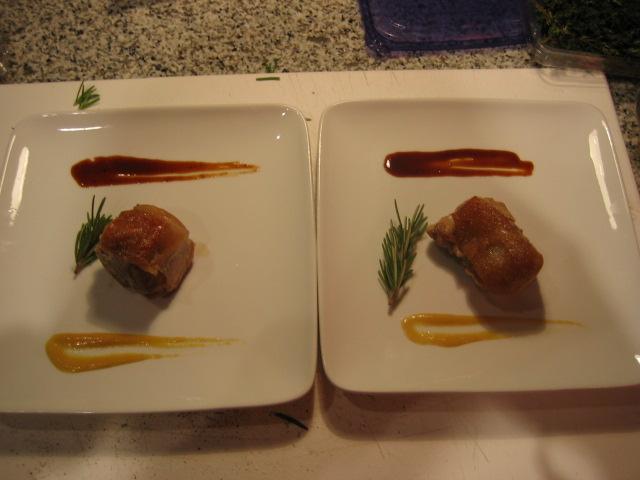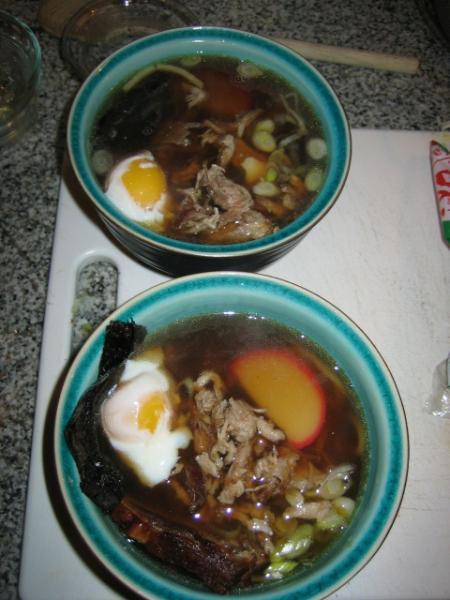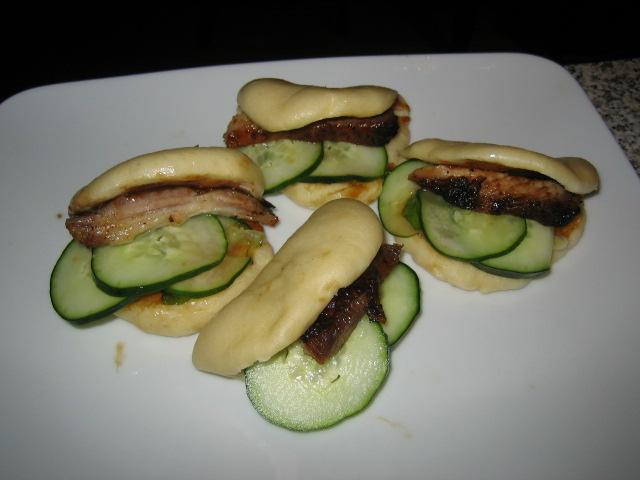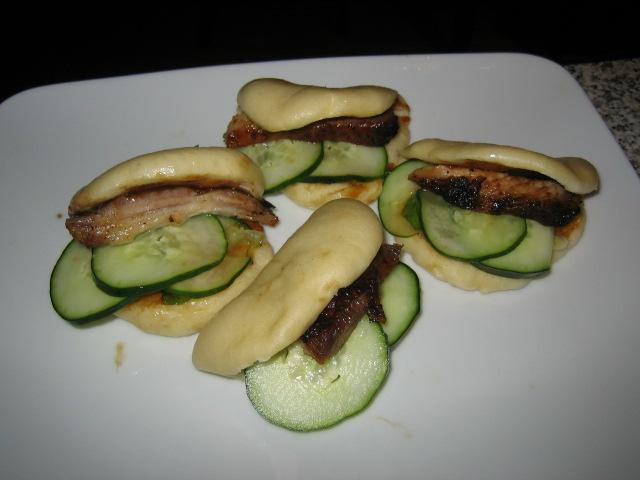-
Posts
29 -
Joined
-
Last visited
-
Here are a couple of in-process shots: 1) Sofrito - I used half the oil as per others' recommendations. Seemed to turn out nicely - we will see 2) First step of dashi - I was able to source the dried sardine and the squid tentacle. My wife and I thought that this was the smell of Japan- smoky, fishy dashi. So good. Excited to see how this turns out.
-
Hello all So I have been cooking with this book since it came out and I have had mostly great experiences. The only things that have not really worked for me were the cereal milk panna cotta (as I mentioned in an earlier post) and the spicy pork sausage with rice cakes (too spicy, though I may not have had the proper ingredients). Huge victories included the fried chicken with octo vinaigrette, which has become a staple in my house, and the pork belly ssam (mustard seed sauce here is amazing). Also the deep fried apple pie (pictured below) is a massive win. I just came back from a weeklong business/pleasure trip to Japan, where the attention to detail and execution in even the simplest convenience store take-out meal stunned me. I ate expensive meals and cheap meals, and I liked the cheap meals best of all. I can see very clearly why this was such a formative experience for Chang. While I was there, I bought some katsuobashi (bonito fish flakes) to make dashi with. But I noticed something in the book: Chang talks about the use of bonito flakes for making dashi and this dashi can be used to make ramen. However, I can't find anything in the book explaining how to make ramen from dashi. In the book, he uses his bacon dashi in some other dishes - clams, as a braise - but not ramen. Does the group have any ideas on how to use dashi to make ramen? Simmer pork bones in dashi for a few hours? Something else? Any ideas would be helpful. Before this book I cooked and ate French almost exclusively. Today for breakfast I made myself slow-poached eggs in alkaline noodles with sriacha. Wow.
-
Hello everyone I bought a baby pig leg from my local independent butcher this week, which is a generally excellent and highly regarded institution. It looked wonderful but when I unwrapped it I noticed a slightly off flavor - sort of like a combination of formaldehyde and sweat. I decided not to worry about it and instead went ahead with my recipe (a pork confit out of Keller's Under Pressure. The recipe involved putting the entire leg, skin on, in the water bath for 8 hours at 175 degrees. Afterwards, I took out the leg and dissected off the meat to make little pork cubes. I've attached a pic of what the final dish looked like, for your viewing pleasure. The "off" flavor seemed concentrated in the skin and subcutaneous fat. It was so disconcerting for me that I ended up tossing the skin entirely and just turning the confited meat into a 'hash' of sorts. The meal ended up okay but I wanted to get some thoughts and suggestions. Has anyone else had experiences like this with weird 'off' flavors from skin-on pork, especially baby pig? Any ideas on how to avoid? Things to request at the butcher? Thanks
-
Whole thing. Konbu, mushrooms, chicken, pork bones, bacon. Took all day but not that much active time. Also - after we were done with the mushrooms we pickled them. Tasty! Glad to hear pickled sunchokes turned out okay. I hate sunchokes - maybe they are nice when pickled
-
We made the ramen last night. It's wonderful. I recommend it highly. The instructions are near-perfect. Eggs were cooked in a water bath. We also made the cereal milk panna cotta but it didn't turn out right. Going to try again.
-
Here's a question that may have been addressed earlier but it's tough to sort through this massive tome. I am looking to take the next step in my sous vide life. I am an avid home chef and I have really taken to SV cooking. I've been using an Auber PID and a crock pot with a Foodsaver and my results so far have been very good. Given how much I've been cooking SV, I think it's worth upgrading my equipment. But I do need to figure out the merits of any purchases before I make them. Cost is not a huge issue though obviously I'd rather save than spend. I would love to hear the group's thoughts on the merits of upgrading to a full laboratory immersion circulator, or if the money is better spent elsewhere. What will a Polyscience do that an Auber will not? Is a commercial vacuum sealer a better purchase? Thanks. FYI sous vide duck leg confit is a daily staple in my house.
-
I bought 'Home Cooking' at Bonnie Slotnick cookbooks in New York. After being inspired by her rapturous description of black cake at the end of the book, we made it ourselves. We liked it so much that we made our own black cake for our wedding cake. Thanks, Laurie
-
Glad to hear there's another Bostonian out there! We just moved here from New York and are trying to import our favorite tastes from back home. I have a dual-fuel oven - gas burners, electric oven. I wonder if my oven ran really hot. I have been looking at pork belly recipes all over the internet trying to figure out how to optimize this. If I can get it right, there's a whole new world of culinary experiences waiting for me.
-
Just got David Chang's Momofuku cookbook. Started with one of our faves - steamed buns with pork belly. See the cookbook thread for a discussion of the technical issues that accompanied this recipe. Still tasty though!
-
We got the book this week and cooked out of it tonight. We have dined at each of the restaurants in the Momofuku mini-empire so we were excited to try out some of our favorites. Before I report on the cooking adventures, I would like to defend the writing voice he uses in the book. It is authentic and natural and I probably drop more f-bombs in casual conversation than he does. I also like his honesty - e.g. pg. 80, on buying premade steamed buns: "How many sandwich shops bake their own bread? Right. Don't kill yourself." Or page 294, Sources: "My answer about sources is pretty simple: Google it." It is really refreshing to hear this after so much precious cookbook prose. So: tonight we decided to make the Momofuku pork buns (pg 79), something we have had at the restaurant many times and have always loved. Overall: It was a success but there were some minor technical issues that will require fixing next time. Pretty standard for the first time cooking from a recipe. Pic of finished product is below. Some notes: 1) The buns (pg 81) were great. We also purchased, as a comparable, some frozen buns from our local Chinese grocery store and they weren't as good. As I write this, we have 40-something more buns that are being steamed. 2) The pickled cucumbers were tasty and easy. I wish I had known about this approach earlier. 3) The belly itself - this is where we had problems. i) The belly we purchased (from Savenor's in Boston) had the skin on, and my butchering was, well, imperfect. ii) The belly cooking technique suggested in the book (450 degrees then down to 250) resulted in a mostly-burned belly that was not completely rendered, so the final product was, in spots, alternating between charcoal and fat. iii) The belly curing in salt and sugar resulted in a too-salty crust. There was some user error here - I should have taken the belly out earlier, in particular. But a quick check of the internet revealed that Chang had provided this recipe to Gourmet magazine (sob!) in 2008, and his technique at that time was quite different - he essentially braises it at low temperature first and then cooks at high heat. Next time, we will make the following changes: a) we will brush off the salt/sugar rub before tossing the belly into the oven; b) we will cook the belly at a lower temperature, maybe first, before browning the belly. The browning will be watched like a hawk to prevent burning; c) we will try to buy less-fatty belly in the first place. If these changes do not result in "perfect" belly we will revert to the Gourmet technique and see if that works. All in all, this was still a really successful dish, and easy too. I would recommend it. Tariq
-
Percyn, that's really helpful, thanks Thanks, Shelby. Going to have a pizza party on Saturday - about 8 people coming over and bringing their favorite toppings. Will photograph and post!
-
Had a fun weekend in the kitchen.. We made a roquefort and leek quiche. Crust was as per the Cook's Illustrated Vodka-based pate brisee. Filling was as per Thomas Keller's recipe in the Bouchon cookbook. This turned out beautifully. Quick tip on this - use lots of extra pastry dough! CI suggests that one only use half of the dough per quiche - but to do it properly a la Keller, you need twice as much. Also have been getting closer to perfection on the margherita pizza. The crust was as per Roberto Donna's formula as seen in a video with Julia Child. Video is here: http://bit.ly/LElD Finally, my fiancee and I made some wonderful macarons. Here's a question: are there any good threads on food photography? I am a pretty decent photographer with full-sized objects but so far food has been completely vexing.
-
Thanks everyone for your suggestions! Glad to hear a confectionery hobby does not have to be financially ruinous. I am looking forward to further experiences as a chocolate-fed guinea pig.
-
Hi there My fiancee has just taken up chocolate- and dessert-making as a serious hobby. This is good news, particularly for me. However, she is currently freaking out (as am I) about how expensive chocolate is. For example, Peter Greweling's Chocolates and Confections has a recipe for an Earl Grey ganache that she is about to attempt. But at retail, it takes about $50 worth of chocolate! This is using Scharffen Berger at retail. Any suggestions for how to do this without the staggering expense? Does it take the use of an alternative chocolate brand? Is there a way to buy it wholesale? We live in NYC so everything is expensive, but I would imagine the power of the Internet could be harnessed somehow. The bottom line is that we want to have the freedom to experiment and make mistakes, which is the heart and soul of cooking. Thanks, and thanks to eGullet.


